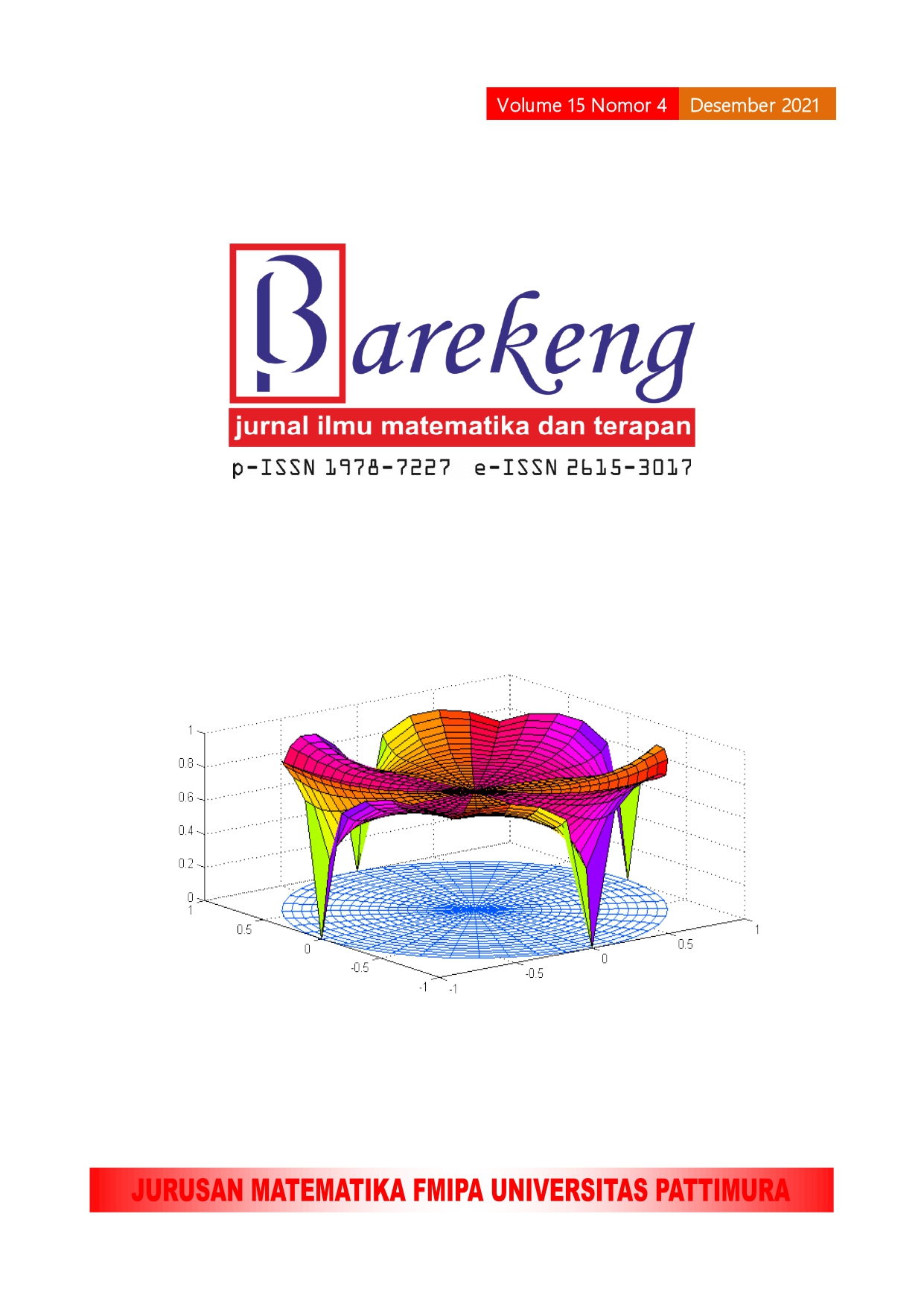SIMULASI PENERAPAN TEORI ANTRIAN DALAM PEMBATASAN PENGUNJUNG OBJEK WISATA
Abstract
Restrictions of the visitor on the tourism places is one of the mechanism of health protocol that carried out during the new normal era. This restriction become a dilemma since the manager of the tourism places want to maximize their profit by allowing all visitor, while the government still limiting the number of visitor to avoid crowding. Otherwise, real-time monitoring of the number of visitor somewhat difficult since they can come in and leave the tourism places at any time. In this study we implement the queuing theory to solve this problem. The visitor of the tourism places is modelled as the customer, while the time spent by them in the tourism places is modelled as the serving duration. By estimating the average of time spent by the visitor and determine the average number of arrivals during the specified time, the number of visitor in the tourism place can be estimated as the number of people in the queuing system. As a preliminary study, this paper only focused on two queuing model, namely the M/M/1 and M/G/1. Further study is needed to develop the model and calibrate it using the data from a specified tourism place.
Downloads
References
L. R. Amir et al., “Student perspective of classroom and distance learning during COVID-19 pandemic in the undergraduate dental study program Universitas Indonesia,” BMC Med. Educ., vol. 20, no. 1, pp. 1–8, 2020, doi: 10.1186/s12909-020-02312-0.
T. Moja, “National and institutional responses–reimagined operations–pandemic disruptions and academic continuity for a global university,” Stud. High. Educ., vol. 46, no. 1, pp. 19–29, 2021, doi: 10.1080/03075079.2020.1859688.
J. Jung, H. Horta, and G. A. Postiglione, “Living in uncertainty: the COVID-19 pandemic and higher education in Hong Kong,” Stud. High. Educ., vol. 46, no. 1, pp. 107–120, 2021, doi: 10.1080/03075079.2020.1859685.
M. Szmigiera, “Impact of the coronavirus pandemic on the global economy - Statistics & Facts,” Statista, 2021.
N. G. Uğur and A. Akbıyık, “Impacts of COVID-19 on global tourism industry: A cross-regional comparison,” Tour. Manag. Perspect., 2020, doi: 10.1016/j.tmp.2020.100744.
D. Dinarto, A. Wanto, and L. C. Sebastian, “Global Health Security–COVID-19: Impact on Bintan’s Tourism Sector,” RSIS Comment. 033-20, 2020.
S. Gössling, D. Scott, and C. M. Hall, “Pandemics, tourism and global change: a rapid assessment of COVID-19,” J. Sustain. Tour., 2020, doi: 10.1080/09669582.2020.1758708.
M. E. Atmojo and H. D. Fridayani, “An Assessment of Covid-19 Pandemic Impact on Indonesian Tourism Sector,” J. Gov. Public Policy, 2021, doi: 10.18196/jgpp.811338.
Direktorat Analisis dan Pengembangan Statistik, Indikator Ekonomi Indikator Ekonomi. Jakarta: BPS RI.
A. Maharani and F. Mahalika, “New Normal Tourism sebagai Pendukung Ketahanan Ekonomi Nasional pada Masa Pandemi,” J. Kaji. LEMHANNAS RI, 2020.
I. D. G. Sugihamretha, “Respon Kebijakan: Mitigasi Dampak Wabah Covid-19 Pada Sektor Pariwisata,” J. Perenc. Pembang. Indones. J. Dev. Plan., 2020, doi: 10.36574/jpp.v4i2.113.
T. Sheikh, S. K. Singh, and A. K. Kashyap, “A Study of Queuing Model for Banking System,” Int. J. Ind. Eng. Technol., 2013.
A. A. Onoja, O. L. Babasola, E. Moyo, and V. Ojiambo, “The Application of Queuing Analysis in modeling Optimal Service level,” Int. J. Sci. Eng. Res., 2018, doi: 10.14299/ijser.2018.01.002.
M. E. Zonderland and R. J. Boucherie, “Queuing networks in healthcare systems,” in International Series in Operations Research and Management Science, 2012.
Y. Ding, D. Gupta, and X. Tang, “Early Reservation for Follow-up Appointments in a Slotted-Service Queue,” SSRN Electron. J., 2020, doi: 10.2139/ssrn.3616565.
S. N. Aulele, “Analisis sistem antrian pada Bank Mandiri cabang Ambon,” BAREKENG J. Ilmu Mat. dan Terap., 2014, doi: 10.30598/barekengvol8iss1pp45-49.
H. MZ and I. Pratiwi, “Analisis sistem antrian dengan metode simulasi,” J. Desiminasi Teknol., 2019.
J. M. Smith, Introduction to Queueing Networks Theory Practice. 2018.
U. N. Bhat, An Introduction to Queueing Theory: Modeling and Analysis in Applications. Birkhäuser Boston, 2008.
S. Dewanto and A. Santosa, “Simulasi Sistem Pelayanan Rawat Jalan di Rumah Sakit Menggunakan Simulasi Kejadian Diskrit,” Ina. J. Ind. Qual. Eng., 2020, doi: 10.34010/iqe.v8i1.2725.
Taha, H.A., Operations Research, 10th edition. 2017.
Authors who publish with this Journal agree to the following terms:
- Author retain copyright and grant the journal right of first publication with the work simultaneously licensed under a creative commons attribution license that allow others to share the work within an acknowledgement of the work’s authorship and initial publication of this journal.
- Authors are able to enter into separate, additional contractual arrangement for the non-exclusive distribution of the journal’s published version of the work (e.g. acknowledgement of its initial publication in this journal).
- Authors are permitted and encouraged to post their work online (e.g. in institutional repositories or on their websites) prior to and during the submission process, as it can lead to productive exchanges, as well as earlier and greater citation of published works.






1.gif)



